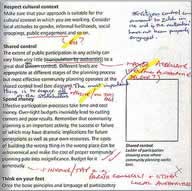- description
- more detail
The nature and structure of the product are determined by the organisers. A draft is drawn up by writers, editors, designers and illustrators.
Drafts are circulated, or displayed, for comment. Participants make comments on the draft with coloured pens or Post-its.
Editors go through the comments and produce a revised draft which is approved by the organisers. The process is repeated as necessary.

Making comments
Specific suggestions for alterations marked on a draft are more useful than general comments (example shown is from a draft of this book).
- Explain the process clearly at the outset. Stress that comments are not automatically included but help the editors make improvements. Appoint one person as editor-in-chief to avoid lengthy wrangling in the event of disagreements. Collective editing sounds good in principle but rarely works well in practice.
- Secure a good cross-section of participants. It is quite extraordinary how few comments will normally be duplicated, even with many people responding.
- Holding an 'editing workshop' can generate ideas that would not emerge from individuals. Use pages pinned up on the walls as a basis for discussion.
- Always circulate material as close as possible to its final form. Sending out text without pictures for instance has limited use.
- Keep the structure simple.
- Be concise. People don't read much. Lengthy reports are only useful for massaging egos. Concentrate on getting the argument right. Using bullet points and headings will help this.
- Be visual. Good images are worth thousands of words. 'Before and After' images are particularly good for conveying proposed changes.
- Using short quotes or soundbites' from people can be very powerful.
- Make sure you credit everyone accurately
- Main costs: photocopying; binding; postage; time.
Simple format to avoid tedious blow-by-blow accounts and assist with compiling reports.
- 1 Workshop title.
- 2 People present name and organisation.
- 3 Issues raised heading and bullet points.
- 4 Proposals heading and bullet points.
Simple format which works in most situations.
- Recommendations (1,2,3 etc. The only thing many people will read)
- The Way Forward (issue 1, issue 2 etc. summary paragraphs)
- Background (why the report is necessary and how it was produced)
- Issues (Main issues in depth optional)
- Ideas (Everything suggested even if not agreed by everyone optional)
- Proposals (what should happen in detail)
-
Appendices (may be separate document)
- Workshop notes
- Credits
- Other relevant info
Dear.............
FOREST ACTION REPORT
COMMENTS PLEASE
A draft mock up of the report arising from the recent design workshop is enclosed.
Please let me have your comments by midday Friday 4 May by tel., fax, post or email.
Any reactions would be useful. But the best help would be if you could mark up all comments as proposed alterations in red pen on the draft and return it. And, if possible, let me have any long sections of new copy by email so I can cut and paste it to reduce the chance of typing errors.
The editing team will produce a revised draft and there will be a final opportunity to see and discuss this on Saturday 5 May from 2 to 6 at the warden's office on Hill Street.
Your help will of course be acknowledged unless you let me know to the contrary.
sincerely
Report Editor
Participation by post and email
Sample letter inviting comments on a report.